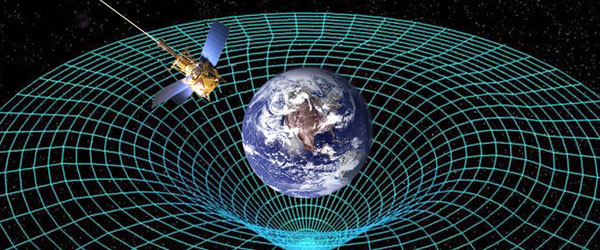Gravity 101 Part I
In both science fiction and the daily news, we are bombarded with talk about various objects in orbit around the Earth, the Sun, other Planets, other stars, and on and on. But, how many of us have more than just glimmer of a clue as to what this means? What does it take to get into and out of orbit? And, once you are in orbit, what is required to move around to link up (or avoid) other objects in orbit? This is actually quite a bit of ground to cover so I’m going to split it into a series of articles.
To begin, we must first get an idea of what it means to be in orbit — which means that we need to have a little knowledge about gravity. To put it in simple terms: gravity is a force that pulls smaller masses towards larger masses (the smaller masses do actually pull against the larger ones, but the size difference is generally so large that the smaller one’s force is effectively zero). Among the four forces in physics (maybe we’ll confront some of the others in the future) it is actually the weakest, but due to the large masses of planets and stars, it is the one that affects us the most dramatically.
The key point to understand about gravity (and it’s also true about the other forces) is that it follows what is called the inverse square law. Without scaring you with mathematics, what this means is that, if you move twice as far away, the pull of gravity is one fourth of what you felt before (two squared is four but it’s the inverse so one fourth, if you move three times the distance then the force will be one ninth). In other words, if you are twice the distance from the center of the earth you will weigh one fourth as much. We should also note that the English units of pounds and the metric units of kilograms are different animals; pounds are units of force, kilograms are units of mass. Pounds are mass times gravity, kilograms are just mass so pounds change if gravity changes but kilograms stay the same.
I suppose that you’ve been told that there is a conversion factor: One pound equals 2.2 kilograms. The is only true in the sense that, if apples cost fifty cents, then two apples equals one dollar. What is true is that 2.2 kilograms of mass exerts one pound of force on the surface of the Earth (subject to gravity). If we fly up to the Moon our 2.2 kilograms object will still be 2.2 kilograms, but it will only exert one sixth of a pound of force on the surface of the Moon.
All right, enough ranting and onto some real science. Let’s consider what it means to be in orbit around the Earth. The basic concept to understand is that objects in orbit are actually falling towards the Earth. The difference is that they are moving fast enough perpendicular to the direction that they are falling that they miss the Earth, but not so fast that they overcome the force of gravity and fly away. I recall that Douglas Adams used that concept in one of his books. He called it flying; sorry Doug, it’s called orbiting.
It’s not really that precarious though. The speed required to break out of orbit and fly away from the Earth is quite large, and objects in orbit tend to remain in orbit unless acted upon by another force. As a side note for the mathematically inclined readers (others can skip to the next paragraph without missing anything), I will not mention the velocity vector (which is tangential to the orbital path and not necessarily orthogonal to the the acceleration vector) since the assumed audience might not be aware of the difference between speed and velocity, but they will understand speed so no nitpicking please.
Now that we understand some of the basics we can, perhaps, dispel one of the common misconceptions about objects in orbit. The misconception is that they are so far away that Earth’s gravity is no longer in affect. This is far from true. Most objects are in what is considered low Earth orbit (LEO) which is 100 – 1200 miles above Earth sea level. Earth sea level is about 3963 miles from the center of the Earth so, for an object in a 200 mile orbit (the International Space Station orbit is about 212 miles) the difference in the distance to the center of the Earth is only about 1.05 greater than sea level:
which translates to a force of gravity approximately 91% of that felt at sea level:
So why are objects in orbit weightless? As mentioned above, it’s because they are falling. You are actually falling into the center of the Earth even when you are standing on the Earth. The ground just pushes back and keeps you in place (so blame the scale, it pushes you to the weight that it reads out). When you are falling the scale is falling, too, so it will read zero but your mass will stay the same.
How fast does an object need to be going to remain in orbit? As I mentioned, it has to be fast enough to miss the earth but not escape. But now the math gets a bit harder. In reality a planetary orbit is described by six unique quantities (I won’t cover them here so don’t get scared). Why six? To put it simply it’s because orbits occur in three dimensional space and, in general, orbits are not circular but elliptical (a circle is really just a special ellipse) and, because they are elliptical, the orbital speed is not constant.
Before everyone gets scared and quits reading, I assure you that we can make very good approximations for low Earth orbits by assuming circular orbits in two dimensions. Most orbital movement is confined to a two dimensional plane anyway, and most of the three dimensional parameters are only useful in comparing different orbits. Perhaps the simplest formula I know for the approximate orbital speed is:
Where a is the distance from the center of the Earth and T is the orbital period (and yes, π, you will always see your old friend π when you encounter periodic motion). For the International Space Station, who’s altitude above sea level is around 212 miles with an orbital period of about 90 minutes, the orbital speed is approximately:
(go look it up if you don’t believe my simple calculations). As a technical note, I used this formula so I wouldn’t have to worry too much about units of measurement. I could have used:
Where G is Newton’s gravitational constant and M is the mass of the Earth but I would then have to dig up G in English units and find M in slugs (“slug” is the English unit of mass; it’s an ugly unit and nobody wants to use it, including me).
Another key concept to note is that the orbital speed is dependent on the distance from the center of the Earth. Objects in more distant orbits move slower than objects in lower orbits. This brings up another interesting, fairly simple, formula that governs planetary orbits. This is most commonly known as Kepler’s third law. Johannes Kepler was an interesting and brilliant character. In the 17th century he was able to deduce his three major laws of planetary motion from stacks and stacks of planetary observations. The amount of insight and hand calculations that went into his work is mind boggling. Kepler’s third law, also called the harmonic law as Kepler was attempting to fit planetary motions to musical harmonics, states the the square of the orbital period is proportional to the cube of the radius (well, okay, the semi-major axis but we’re assuming circular orbits so call it the radius). If the word “proportional” scares you it’s all right. All it means is that the ratio of these two values is a constant value and, in general, we really don’t need to know what that constant value is. For example, we know that for the ISS whose period is 90 minutes (1.5 hours) and the radius is 4175 miles (3963 + 212) so we can use that to determine the radius required for a geosynchronous orbit (an orbit where the object remains fixed above a point on the Earth). How? First, for ISS:
Hopefully the scientific notation isn’t too scary, and, by the way, that’s your constant, let’s call it C. Then:
Take the cube root:
And the orbital speed (stay with me now):
Again, these values are approximations but they are close enough to get an idea of what is going on. The ISS in LEO travels about two and a half times faster than the object in geosynchronous orbit. The difference in orbital speeds is due to conservation of angular momentum. The classic illustration of conservation of angular momentum is the spinning ice skater. With arms extended the skater spins at a certain rate. As he (I’ll use he, the classics usually say she) brings his arms into his body, he spins faster. Bringing your arms in doesn’t add any energy to your spin, you spin faster to maintain the same energy level (remember, there ain’t no such thing as a free lunch – TANSTAAFL).
I imagine that your head is getting full from all these numbers so let’s break here and look at what we have learned today:
- Gravity doesn’t pull, the Earth sucks (okay, okay, I stole that from one my Physics professors).
- Orbiting objects are falling, they just miss.
- Pluto moves really really slow so it can’t be a planet.
- Physics Conservation Laws say that you have to pay for your own lunch.
In the next article we’ll take a look at moving around in the orbital environment. Things get a bit weird out there so hold onto your hats.






Reblogged this on Ray A. Davis and commented:
Very nice article technical enough for those who needed and simplified enough for the masses. Great job!